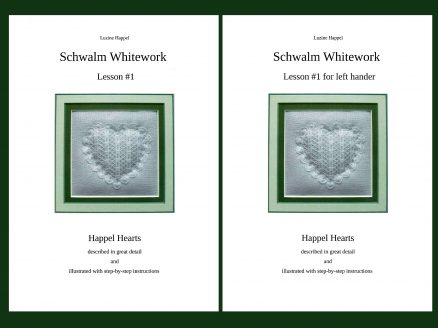As I grow older I begin to think of rounding off my publications so to ensure the continued interest in and working of Schwalm whitework.
My book Basic Principles of Schwalm Whitework has been well received. Schwalm embroiderers like it and have it always at their fingertips. However, these embroiderers have also told me that the book’s project is much too ambitious for beginners.
And so, I took out small parts, described them in substantially more detail, and added many more step-by-step pictures. I now plan to offer four different lessons for beginners. They will allow one to learn – completely self directed – the extensive techniques of Schwalm whitework step by step. All instructions have been proofed by many students.
The publications are:
Lesson #1 – Happel Hearts
Lesson #2 – Tulip Wreath
Lesson #3 – Openwork Circle Design Ornaments
Lesson #4 – Needle-Weaving Band Sampler
Although the first lesson – Happel Hearts – has already been presented as an online class n, each of the lessons will be discussed in greater detail in future articles.
Lesson #1 will now be offered without my online help. However, for one to succeed it is important to learn about the materials used in Schwalm whitework. For that reason I will offer a kit containing all the needed supplies. (Details of the kit will be included in a future article.) For your convenience, the kit will include all supplies needed for lesson #1 and lesson #3. There will also be a small sample of the linen used in lesson #2.
A newcomer to Schwalm whitework should absolutely start their studies with lesson #1. After completing this lesson, one can choose to continue either with lesson #2 or with lesson #3. Lesson #4 is a stand-alone unit that only requires some basic knowledge of embroidery.
The lesson booklets are also well suited for Schwalm teachers. The step-by-step instructions and many pictures will enhance and support a teacher’s lesson.
A word about the linen, Schwalm whitework is a combination of surface embroidery and drawn thread work. It is worked on densely woven pure linen. The dense weave enables perfect surface embroidery like leaves, stems, small flowers, eyelets, and tendrils. And withdrawing threads facilitates stitching the filling patterns into the shapes.
The most widely used linen for Schwalm whitework is linen with 16 threads per cm (Weddigen article 925). But for beginners it is difficult to withdraw the fabric threads of this linen. So all lessons (#1, #3, and #4) that deal mostly with this subject are worked on linen with a lower thread count – 13.5 threads per cm (Weddigen article 160).
One of the goals of lesson #2 was to learn how to embroider on the finer linen. But in the proofing tests some of the ladies found it difficult to use this linen. So the lesson was redesigned. Now the same design and the same steps can be worked optionally on either the 16 threads per cm or the 13.5 threads per cm linen. As mentioned above, the kit for lesson #1 will also include a small sample piece of linen with16 threads per cm.
Please anticipate more information on the individual lessons soon.
Coming soon:
All booklets and kits are ready for purchase, however they have not yet been added to my online shop. If you would like to purchase or have any questions regarding these items, please email me at leuchtbergverlag@aol.com.







Thank you for replying and telling me about the booklets. Could you tell me the price of lessons 1 and 2? Do you have any lessons on how to do cut work embroidery?
I have done some in the past but it has been a long time. It was done with Coton a broder, now hard to find.
.
The lesson booklets #1 and #2 are €25 each (including 7 % sales tax), 23.36 € outside the EU.
A lesson for cut work, filled with needlelace, I did not establish so far.
Da ich schon lange mit dem Gedanken spiele die Technik zu erlernen freue ich schon auch die Lektionen und auch auf das entsprechende Materialpaket. Oder ich mache erst mal den Onlinekurs. Ich werde es mir überlegen.